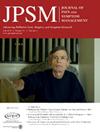The Lost Leading the Lost: A Surrogacy Conundrum
IF 3.2
2区 医学
Q2 CLINICAL NEUROLOGY
引用次数: 0
Outcomes
1. Participants will develop a framework for thinking critically about and analyzing their experiences with evaluating capacity at the end of life.
2. Participants will think critically about evaluating the appropriateness of surrogate decision-makers at the end of life and how this might be incorporated into their practice.
Key Message
This presentation takes a case-based approach to crucial issues at the intersection of ethics and palliative care. It is a close dissection of how we think about capacity, surrogate decision-making, and what it means to act in the best interest of the patient.
Abstract
(The Case) Gertie is a 93-year-old with advanced dementia admitted with a UTI to a community hospital. She is essentially nonverbal, says one to two words in your 30-minute inpatient intake visit. She is accompanied by her lifelong friend, Dale. He has lived with her for more than 20 years and they have no other family. You and your team meet with Dale, in his 80s, at the bedside. They have never talked about what she would have at end-of-life. While Dale acknowledges that they need more help than he can provide at home, he is unsure of what his next decision should be. Information about hospice is provided. Two days later, you meet with Dale as planned. It becomes clear that he does not recall your last conversation. How do we decide what happens to Gertie?
Results / Resolution
In this case, an informal conversation was had with some of the Ethics consultants at an affiliated institution who provided additional clarity. Because Gertie was not safe to be discharged home, and there was no additional treatment to offer, the threshold for competency was fairly low, because there was no safe alternative. The decision was made to have her discharge to a nursing home facility with hospice overlay.
Conclusion
So often we ask patients to designate surrogate decisionmakers in the event they are incapacitated, but we may fail or be unable to verify the appropriateness or capacity of the surrogates themselves until we are already in a dire situation. In cases where surrogate decisionmakers are of advanced age, it might be reasonable to ask patients to nominate multiple surrogates who they feel might be able to call on to act in their best interests.
References
Appelbaum PS. Clinical practice. Assessment of patients' competence to consent to treatment. N Engl J Med. 2007 Nov 1;357(18):1834-40. doi: 10.1056/NEJMcp074045. PMID: 17978292.
迷失的人领导迷失的人:一个代孕难题
Outcomes1。参与者将建立一个框架,批判性地思考和分析他们的经历,评估生命结束时的能力。参与者将批判性地思考在生命结束时评估替代决策者的适当性,以及如何将其纳入他们的实践。本次演讲采用基于案例的方法来解决伦理和姑息治疗交叉的关键问题。这是对我们如何看待能力、替代决策以及为患者最佳利益行事意味着什么的细致剖析。摘要(病例)Gertie是一名93岁的晚期痴呆症患者,因尿路感染被一家社区医院收治。她基本上是不会说话的,在你30分钟的住院就诊中只会说一两个词。陪伴她的是她一生的朋友戴尔。他和她一起生活了20多年,他们没有其他家人。你和你的团队去见戴尔,他已经80多岁了,在病床边。他们从未谈论过她临终时会有什么。虽然戴尔承认,他们需要的帮助比他在家里能提供的更多,但他不确定自己的下一个决定应该是什么。提供有关安宁疗护的资讯。两天后,你按计划和戴尔见面。很明显,他不记得你们上次的谈话了。我们怎么决定格蒂的下场?结果/解决方案在这种情况下,与附属机构的一些道德顾问进行了非正式对话,他们提供了额外的清晰度。因为Gertie出院回家并不安全,也没有额外的治疗可以提供,能力的门槛相当低,因为没有安全的替代方案。决定让她出院到一家有临终关怀覆盖的养老院。因此,我们经常要求患者在无行为能力的情况下指定代理决策者,但我们可能无法或无法验证代理本身的适当性或能力,直到我们已经处于一个可怕的情况下。在代理决策者年事已高的情况下,要求患者提名多名他们认为可能能够根据他们的最佳利益行事的代理可能是合理的。appelbaum PS.临床实践。评估病人同意治疗的能力。中华医学杂志,2007,31(6):559 - 564。doi: 10.1056 / NEJMcp074045。PMID: 17978292。
本文章由计算机程序翻译,如有差异,请以英文原文为准。
求助全文
约1分钟内获得全文
求助全文
来源期刊
CiteScore
8.90
自引率
6.40%
发文量
821
审稿时长
26 days
期刊介绍:
The Journal of Pain and Symptom Management is an internationally respected, peer-reviewed journal and serves an interdisciplinary audience of professionals by providing a forum for the publication of the latest clinical research and best practices related to the relief of illness burden among patients afflicted with serious or life-threatening illness.

 求助内容:
求助内容: 应助结果提醒方式:
应助结果提醒方式:


